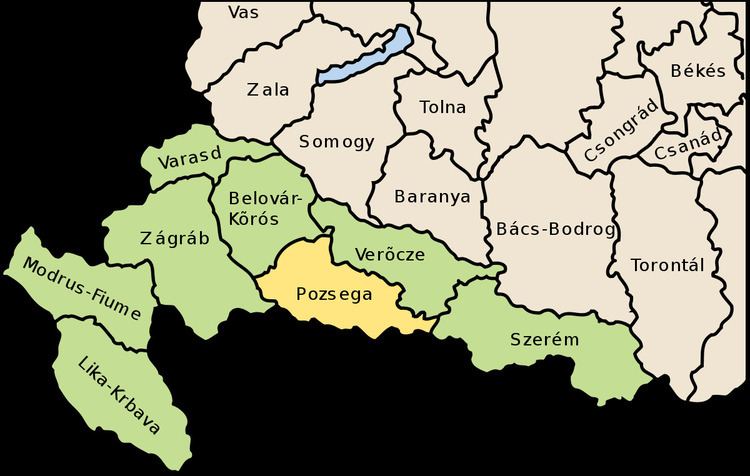1910 4,933 km (1,905 sq mi) | Established 12th century 1910 265,272 | |
 | ||
Požega County (Croatian: Požeška županija; Hungarian: Pozsega vármegye) was a historic administrative subdivision (županija) of the Kingdom of Croatia-Slavonia. Croatia-Slavonia was an autonomous kingdom within the Lands of the Crown of Saint Stephen (Transleithania), the Hungarian part of the dual Austro-Hungarian Empire. Its territory is now in eastern Croatia. The capital of the county was Požega (Croatian, in Hungarian: Pozsega).
Contents
Geography
Požega county shared borders with the Austrian land Bosnia-Herzegovina and the counties of Zagreb, Bjelovar-Križevci, Virovitica and Srijem (all in Croatia-Slavonia). The county stretched along the left (northern) bank of the river Sava. Its area was 4933 km² around 1910.
History
The territory of Požega County was part of the Kingdom of Croatia when it entered a personal union with the Kingdom of Hungary in 1102, and with it became part of the Habsburg Monarchy in 1526. Požega County was re-established after it was liberated from Ottoman occupation in the late 17th century. In 1920, by the Treaty of Trianon the county became part of the newly formed Kingdom of Serbs, Croats and Slovenes (later renamed to Yugoslavia). Since 1991, when Croatia became independent from Yugoslavia, the county is part of Croatia.
Demographics
In 1900, the county had a population of 229,361 people and was composed of the following linguistic communities:
Total:
According to the census of 1900, the county was composed of the following religious communities:
Total:
In 1910, the county had a population of 265,272 people and was composed of the following linguistic communities:
Total:
According to the census of 1910, the county was composed of the following religious communities:
Total:
Subdivisions
In the early 20th century, the subdivisions of Pozsega county were:
